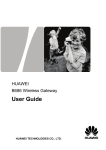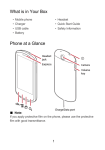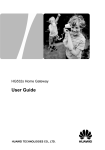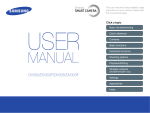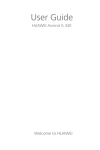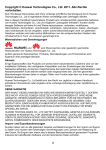Download User Guide - TotalAircard.com
Transcript
HUAWEI B686 Wireless Gateway User Guide HUAWEI TECHNOLOGIES CO., LTD. Copyright © Huawei Technologies Co., Ltd. 2012. All rights reserved. No part of this document may be reproduced or transmitted in any form or by any means without prior written consent of Huawei Technologies Co., Ltd. The product described in this manual may include copyrighted software of Huawei Technologies Co., Ltd. and possible licensors. Customers shall not in any manner reproduce, distribute, modify, decompile, disassemble, decrypt, extract, reverse engineer, lease, assign, or sublicense the said software, unless such restrictions are prohibited by applicable laws or such actions are approved by respective copyright holders under licenses. Trademarks and Permissions , , and are trademarks or registered trademarks of Huawei Technologies Co., Ltd. Other trademarks, product, service and company names mentioned are the property of their respective owners. Notice Some features of the product and its accessories described herein rely on the software installed, capacities and settings of local network, and may not be activated or may be limited by local network operators or network service providers. Thus the descriptions herein may not exactly match the product or its accessories you purchase. Huawei Technologies Co., Ltd. reserves the right to change or modify any information or specifications contained in this manual without prior notice or obligation. NO WARRANTY THE CONTENTS OF THIS MANUAL ARE PROVIDED "AS IS". EXCEPT AS REQUIRED BY APPLICABLE LAWS, NO WARRANTIES OF ANY KIND, EITHER EXPRESS OR IMPLIED, INCLUDING BUT NOT LIMITED TO, THE IMPLIED WARRANTIES OF MERCHANTABILITY AND FITNESS FOR A PARTICULAR PURPOSE, ARE MADE IN RELATION TO THE ACCURACY, RELIABILITY OR CONTENTS OF THIS MANUAL. TO THE MAXIMUM EXTENT PERMITTED BY APPLICABLE LAW, IN NO CASE SHALL HUAWEI TECHNOLOGIES CO., LTD. BE LIABLE FOR ANY SPECIAL, INCIDENTAL, INDIRECT, OR CONSEQUENTIAL DAMAGES, OR LOST PROFITS, BUSINESS, REVENUE, DATA, GOODWILL OR ANTICIPATED SAVINGS. Import and Export Regulations Customers shall comply with all applicable export or import laws and regulations and will obtain all necessary governmental permits and licenses in order to export, re-export or import the product mentioned in this manual including the software and technical data therein. Please visit www.huaweidevice.com/worldwide/support/hotline for recently updated hotline and email address in your country or region. Table of Contents 1 Getting to Know Your Device ............................... 1 1.1 Application Scenario .......................................................... 1 1.2 Appearance ....................................................................... 2 1.3 Screen Icons ..................................................................... 4 2 Computer Requirements ...................................... 5 3 Installation ............................................................ 5 3.1 Installing a SIM Card ......................................................... 5 3.2 (Optional) Installing the Table Stand .................................6 3.3 (Optional) Installing an External Antenna ..........................6 3.4 Installing the Handset Battery ........................................... 7 3.5 Connecting to a Computer ................................................ 7 3.6 Connecting to a USB Device ............................................. 8 3.7 Connecting the Router to a Power Outlet ..........................8 3.8 Charging the Handset ....................................................... 9 4 Powering the Device On or Off ............................ 9 4.1 Powering the Router On or Off .......................................... 9 4.2 Powering the Handset On or Off ....................................... 9 5 Registering the Handset..................................... 10 6 Setting Up a Wireless Connection ..................... 11 6.1 Turning the Router's Wi-Fi On or Off ...............................11 6.2 Setting Up a Wi-Fi Connection Manually .........................11 6.3 Setting up a Wi-Fi Connection through the WPS ............12 i 7 Accessing the Internet ....................................... 12 8 Logging In to the Web Management Page ......... 13 9 Using the Handset ............................................. 13 9.1 Call Functions ................................................................. 13 9.2 Message Functions......................................................... 14 9.3 Text Input Methods ......................................................... 15 9.4 Settings Configuration .................................................... 16 10 Restoring Factory Defaults............................... 17 11 FAQs ................................................................ 18 12 Safety Information ............................................ 19 ii Figures in this guide are only for your reference. For details about the particular model you have chosen, contact your service provider. Check the information about the product and its accessories when you purchase it. Some accessories are not provided in the product package. If necessary, contact your local dealer to purchase them. This guide briefly describes the device functions. For details about how to set the management parameters, see the help information on the web management page. 1 Getting to Know Your Device 1.1 Application Scenario Your device provides both data and voice services. You can connect your computer to the router to access the Internet, or use a handset to make a call after registering it with the router. The specific connection steps depend on your computer's operating system. 1 1.2 Appearance Router 1 2 Power button Wi-Fi/WPS button Handset Press and hold this key to power the router on or off. Press and hold this key to active the Wi-Fi or WPS connection. 3 Handset registering/paging button 4 Handset status indicator 5 USB indicator Press and hold this key to register a handset. Press this key to page all the registered handsets. Steady on: At least one handset registered. Fast blinking: Handset registration in progress. Slow blinking: Handset paging in progress. Off: No handsets registered. Steady on: USB storage device connected. Off: USB storage device not connected. 2 6 Wi-Fi/WPS indicator 7 Network status indicator 8 9 Power indicator / / / LAN indicators Steady on: Wi-Fi turned on. Blinking: WPS connection being set up. Off: Wi-Fi turned off. Red fast blinking: Subscriber Identity Module (SIM) card unavailable (SIM card not installed or malfunctioning, or PIN code not verified). Steady yellow: Router registered with the network. Steady green: Router connected to the Internet. Off: No signal received. Steady on: Router powered on. Off: Router powered off. Steady on: Ethernet cable connected. Blinking: Data transfer in progress. Off: Network cable not connected. 10 External antenna port Connect an external antenna to this port. 11 Power port Connect a compatible power adapter to this port. 12 USB port Connect a USB flash drive, portable hard disk drive, or USB printer to this port. 13 LAN ports Connect a computer to one of these ports using an Ethernet cable. Navigation keys 14 15 Left function key Access the main menu by pressing the OK key in standby mode. Access a shortcut menu by pressing the corresponding navigation key in standby mode. Adjust the volume by pressing the navigation keys during a call. Select the option displayed in the lower left corner of the screen. 3 16 Speaker key Activate the hands-free mode when making or answering a call. 17 Call/Send key Make or answer a call. View the dialed call log in standby mode. 18 Mute key Press this key to mute or unmute an ongoing call. 19 Shortcut key Press this key to use the shortcut function. 20 Intercommunication key Press this key to access the list of registered handsets in standby mode. 21 Number and symbol keys 22 23 24 End key Enter numbers, letters, and symbols. Number keys (2–9): Speed-dial a user-assigned phone number by pressing and holding a key in standby mode. # key: Switch between text input methods in editing mode. * key: Display the symbol list in editing mode. End or reject a call. Press and hold this key to power a handset on or off. Return to the standby mode. Clear key Press this key to delete the character to the left of the cursor in editing mode. Right function key Select the option displayed in the lower right corner of the screen. 1.3 Screen Icons Signal strength Battery level Alarm clock Silent mode Handset registered with the router Unread message Forwarding of all calls enabled 4 2 Computer Requirements The recommended computer specification is as follows: Central processing unit (CPU): Pentium 500 MHz or faster Random access memory (RAM): ≥ 128 MB Hard drive: 50 MB disk space available Operating system: Windows 2000, Windows XP, Windows Vista, Windows 7, or Mac OS Liquid crystal display (LCD) resolution: At least 800 x 600 pixels (1024 x 768 pixels is recommended.) 3 Installation 3.1 Installing a SIM Card 1. Slide the card cover off the router. 2. Insert the SIM card into the card slot. Ensure that the gold contact area faces down and that the beveled edge of the SIM card aligns with that of the card slot. 3. Slide the card cover back onto the router. Before removing the SIM card, ensure that the router is powered off and disconnected from the power outlet. 5 3.2 (Optional) Installing the Table Stand You can place the router on a flat surface such as a table or a desk, or hang it on a wall. You can also use the table stand on the router to place it upright. To use the table stand, insert its latches into the router's table stand slots, as shown in the following figure. To ensure good signal reception, place the router in a high place or near a window. To prevent interference caused by radio signals, place the router at least 1 meter (3.28 feet) away from other electrical devices. 3.3 (Optional) Installing an External Antenna In areas with poor network coverage, connect an external antenna to the router's external antenna port. Screw the external antenna in fully, as shown in the following figure. 6 Skip this section if you do not need to connect an external antenna to the router. Before using an external antenna, log in to the web management page (http://192.168.1.1) and set antenna mode to outer. For details, see the help information on the web management page. Only use the external antenna indoors. 3.4 Installing the Handset Battery 1. Slide the battery cover off. 2. Insert the battery into the battery slot. Ensure that the golden contacts of the battery mate securely with those in the battery slot. 3. Slide the battery cover back onto the handset. If the handset will not be used for a long time, remove the battery from the handset. 3.5 Connecting to a Computer Use an Ethernet cable to connect a computer to one of the router's LAN ports, as shown in the following figure. When the connection between the router and the computer is set up, the router's corresponding LAN indicator turns on. Ensure that the Ethernet cable is not longer than 100 meters (328 feet). 7 3.6 Connecting to a USB Device You can connect a USB flash drive, portable hard disk drive, or USB printer to the router's USB port, as shown in the following figure. For details, see the help information on the web management page. Do not connect a computer to the router's USB port. The router's USB port can supply a maximum current of 500 mA to power connected USB devices. If the current required by a portable hard disk drive (or other peripherals) connected to the router is higher than 500 mA, the router may fail to recognize the hard disk drive. In this case, use an auxiliary power supply for the hard disk drive. For more information, contact your service provider. 3.7 Connecting the Router to a Power Outlet Connect a compatible power adapter to the router's power port, and then plug the power adapter into a power outlet. Using an incompatible power adapter may damage the router. 8 3.8 Charging the Handset Use a compatible power adapter to charge your handset. 1. Place the handset into the handset base. Ensure that the golden electrical contacts of the handset and base mate securely. 2. Connect a compatible power adapter to the handset base's power port, and then connect the power adapter to a power outlet. On delivery, a new handset's battery will be low. Charge the handset for a while before attempting to power it on for the first time. Using an incompatible power adapter may damage the handset or handset base. 4 Powering the Device On or Off 4.1 Powering the Router On or Off After connecting to a power outlet, the router will power on automatically. To manually power the router on, press and hold turn on. until all indicators To manually power the router off, press and hold turn off. until all indicators 4.2 Powering the Handset On or Off To power the handset on, press and hold until the screen lights up. To power the handset off, press and hold 9 until the screen turns off. 5 Registering the Handset Skip this section if your handset is registered with the router. Register a handset with the router before using it. Otherwise, you cannot use the handset. To register a handset: 1. Press and hold on the router for over 3 seconds until blinks quickly. 2. On the handset, select Settings > Handset > Register handset. 3. Press the up and down navigation keys to scroll to the base with which you want to register the handset, and then enter the registration password. 4. Press the OK key to register the handset with the base. The default registration password is 0000. To change the password, select Settings > Base > Security > Change system PIN. When registering a handset with the router, ensure that the handset is near the router. After the handset is registered, use the handset within range of the router. Otherwise, the handset will display a message and disconnect from the router. You can register a maximum of six handsets with the router. Press on the router. When blinks slowly, you can page all handsets that have registered with the router. To deregister the handset, select Settings > Handset > Deregister handset. You cannot use the handset after it has been deregistered. 10 6 Setting Up a Wireless Connection Before setting up a Wi-Fi connection, ensure that a wireless network adapter has been installed on your computer. If the wireless network adapter is functioning correctly, you will be able to find a wireless network connection in your computer's connection manager application. 6.1 Turning the Router's Wi-Fi On or Off By default, the router's Wi-Fi automatically turns on when the router is powered on. To manually turn Wi-Fi on, press and hold on. until To manually turn Wi-Fi off, press and hold for 2 seconds, and then release your finger. The turns steady indicator turns off. 6.2 Setting Up a Wi-Fi Connection Manually 1. Ensure that is steady on. 2. Scan for available wireless network connections using your computer's connection manager application. 3. Connect to the wireless network that has the same service set identification (SSID) as the router. If a security mechanism has been enabled for the wireless network connection, enter the correct Wi-Fi key. The default SSID and Wi-Fi key are printed on the router label. To protect your wireless network from unauthorized access, change the SSID and Wi-Fi key. For details, see the help information on the web management page. 11 6.3 Setting Up a Wi-Fi Connection through the WPS If the client to which your router connects supports WPS, a network key is generated automatically. To set up a WPS connection: 1. Ensure that is steady on. 2. Press and hold until blinks to activate the WPS connection on your router. 3. Activate the WPS connection on the client. For details about the client's operations, see its user guide. 7 Accessing the Internet After a connection between your router and the client is set up, you can access the Internet using the modes listed in the following table. Select an appropriate mode according to your data service charging plan. For example, if you are charged according to the length of time you are connected to the Internet, it is recommended that you select manual mode. For details about your data service charging plan, contact your service provider. Mode Description Auto After being powered on, the router will automatically connect to the Internet. Once connected, the router will not automatically disconnect from the Internet. Manual Log in to the web management page, and then connect to or disconnect from the Internet as prompted. On Demand After being powered on, if there is data being transferred, the router will automatically connect to the Internet. If no data is transferred within a pre-defined period, the router will automatically disconnect from the Internet. 12 8 Logging In to the Web Management Page You can configure and manage the router settings using the web management page. For details, see the help information on the web management page. 1. Launch a web browser, and enter http://192.168.1.1 in the address bar. 2. Enter the password, and log in to the web management page. The default password is admin. To protect your router, only one user can log in to the web management page at a time. To protect your account, change the password promptly. For details, see the help information on the web management page. 9 Using the Handset 9.1 Call Functions Making a Call 1. In standby mode, enter a phone number. 2. Press to place a call. 3. Press to cancel or end the call. In standby mode, press to view the dialed call log. Find the desired number, and then press to place a call to that number. Find the desired number in contacts, and then press call the number. Answering or Rejecting a Call to When there is an incoming call, press reject the call. to 13 to answer the call or Making an Internal Call To make an internal call: 1. In standby mode, press the intercommunication key. 2. Press the up and down navigation keys to scroll to the handset to which you want to place the internal call. 3. Press to initiate an internal call. 4. Press to cancel or end the call. Transferring a Call To transfer an ongoing call from an external number to another handset: 1. Press the intercommunication key to scroll to the handset to which you want to transfer the call. 2. Press to connect to the desired handset. 3. Press to end the call between the current and desired handset. The call is transferred to the desired handset. 9.2 Message Functions Creating a Message 1. Select Messages > Create message. 2. Edit the message. 3. Press the OK key and then add a recipient using the following methods: Enter the recipient's phone number. Add the recipient from the contacts. 4. Press the OK key to send the message. Reading a Message The handset stores received messages in the inbox. 1. Select Messages > Inbox. 2. Press the up or down navigation key to scroll to a message in the list. 3. Press the OK key to open and read the message. 4. Press the left function key to manage the message. 14 9.3 Text Input Methods Switching Between Input Methods In editing mode, press the # key to switch between input methods. In editing mode, you can press to delete the character to to delete all the left of the cursor or press and hold characters. In Predictive or Traditional English input mode, you can press the 0 key to enter a space. When Predictive English Input is turned on, you will not be able to switch to Traditional English Input by pressing the # key. To turn off Predictive English Input, select Options > Input Option in editing mode. In any input mode, press the * key to display the symbol list. Inputting English with Predictive English Input (T9) 1. Press the keys labeled with the letters required to spell the desired word once according to the spelling sequence of the word. As you enter the letters, the handset predicts the desired word and displays candidate words. 2. Press the navigation keys to scroll to the desired word. 3. Press the OK key to enter the word followed by a space. Inputting English with Traditional English Input In ABC or abc text input mode, press the number keys to enter letters. Press a number key repeatedly until the desired character appears. If the next letter you want to enter is on the same key as the current one, wait until the current letter is entered, and then enter the next one. Inputting Numbers Switching to the 123 input mode, enter a desired number by pressing the number key. 15 9.4 Settings Configuration To configure and customize your handset settings, select Menu > Settings. Configuring Date and Time To set the date, select Settings > Date and time > Date, enter current date by pressing the number key. To set the time, select Settings > Date and time > Time, enter current time by pressing the number key. Configuring the Handset Lock To set the handset lock, select Settings > Handset > Security > Phone password. You can change the default handset lock code (0000) to a personal password. Before restoring factory settings, you must enter the correct handset lock code. Locking or Unlocking the Keypad In standby mode, press and hold the # key to lock the keypad. In standby mode, press the left function key and then the * key to unlock the keypad. Entering the PIN and PUK A Personal Identification Number (PIN) protects your SIM card from unauthorized use. A PIN Unblocking Key (PUK) is used to change a blocked PIN. If you enter your PIN incorrectly a number of times consecutively, your SIM card will be locked and the handset asks you to enter the PUK to unlock it. Both the PIN and the PUK are supplied with the SIM card. For details, contact your service provider. 16 10 Restoring Factory Defaults If you are uncertain of which settings you have configured or changed, you can restore the factory defaults that the device came with, and then reconfigure the device. Restoring the Router To restore the router’s factory defaults, keep the router powering on, use a sharp-pointed object to press and hold the RESET button until all indicators ( , , , , and ) blink. After the factory defaults are restored, the router will restart automatically. Restoring the router to its factory settings will erase all user settings (including the handset base settings) and restore all settings on the web management page to their default values. If you want to remain the handset base settings, log in to the web management page to restore. For details, see the help information on the web management page. Restoring the Handset To restore the handset to its factory settings, select Settings > Handset > Reset settings. To restore the handset base to its factory settings, select Settings > Base > Reset settings. Restoring the handset to its factory settings will not affect its registration state. Settings that are configured using the handset's base settings menu, including network, call, and security settings, take effect on the router. 17 11 FAQs If problems occur during the use of the device, refer to the following sections for suggested solutions. If the problems persist, contact your device vendor. The device does not work properly. What can I do? Restart the router or handset. Restore the router or handset to its factory settings. Log in to the web management page to see the help information. Contact your service provider. The handset will not power on. What can I do? 1. Remove the battery cover and check that the battery is installed correctly. 2. If the battery is correctly installed, a possible cause for the problem is that the battery is low. Charge the battery, and then try to power on the handset. No information is displayed on the handset screen. Why? If the handset has not been used for a long time or the battery runs out of power, the handset may not display any information when it is being charged. This is normal. The handset can be powered on after the battery has been charged for a while. The battery cannot be charged. What can I do? 1. 2. 3. 4. Check that the handset is correctly mated with the handset base. Check that the handset base and the power adapter are connected correctly. Check that the power adapter and the power socket are connected correctly. Replace the power adapter or the battery with a new one of the same model. The handset continuously searches for the router. What can I do? 1. Check that the router is powered on. 2. Re-register the handset with the router. You do not need to deregister the handset first. The signal strength is weak. What can I do? 1. Check that the SIM card is installed correctly. 2. Place the router at a location where signal reception is good. 18 The call volume is too high or too low. What can I do? During a call, use the navigation keys to adjust the volume. 12 Safety Information This section contains important information pertaining to the operating instructions of your device. It also contains information about how to use the device safely. Read this information carefully before using your device. Electronic Device Do not use your device if using your device is prohibited. Do not use the device when using your device causes danger or interference with electronic devices. Medical Device Follow rules and regulations set forth by hospitals and health care facilities. Do not use your device when using the device is prohibited. Some wireless devices may affect the performance of hearing aids or pacemakers. For any such problems, consult your service provider. If you are using an electronic medical device, consult the doctor or the device manufacturer to confirm whether radio waves affect the operation of this device. Potentially Explosive Atmosphere Do not use your device in any area with a potentially explosive atmosphere, and comply with all signs and instructions. Areas that may have potentially explosive atmospheres include the areas where you would normally be advised to turn off your vehicle engine. Triggering of sparks in such areas could cause an explosion or a fire, resulting in bodily injuries or even deaths. Do not use your device at refueling points such as service stations. Comply with restrictions on the use of radio equipment in fuel depots, storage, and distribution areas, and chemical plants. In addition, adhere to restrictions in areas where blasting operations are in progress. Before using the device, watch out for areas that have potentially explosive atmospheres that are often, but not always, clearly marked. Such locations include areas below the deck on boats, chemical transfer or storage facilities, and areas where the air contains chemicals or particles such as grain, dust, or metal powders. Ask the manufacturers of vehicles using liquefied petroleum gas (such as propane or butane) whether this device can be safely used in their vicinity. Traffic Security Observe local laws and regulations while using the device. To prevent accidents, do not use your wireless device while driving. 19 Do not talk on the handset while driving. Use hands-free accessories. RF signals may affect electronic systems of motor vehicles. For more information, consult the vehicle manufacturer. In a motor vehicle, do not place the device over the air bag or in the air bag deployment area. Otherwise, the device may hurt you owing to the strong force when the air bag inflates. Do not use your device while flying in an aircraft and before boarding an aircraft. Using wireless devices in an aircraft may cause danger to the operation of the aircraft and disrupt the wireless telephone network. It may also be considered illegal. Operating Environment Do not use or charge the device in dusty, damp, and dirty places or places with magnetic fields. Otherwise, it may result in a malfunction of the circuit. While using the device, observe the local laws and regulations, and respect others' privacy and legal rights. Place the device or accessories in well-ventilated, cool, and out-of-direct-sunlight place. Avoid enveloping the device, or covering towels and placing articles on the device. Place the device out of a box or case to avoid poor heat dissipation that results in the damage to the device. On a stormy day with thunder, do not use your device, to prevent any danger caused by lightning. When you are on a call, do not touch the antenna. Touching the antenna affects the call quality and results in increase in power consumption. As a result, the talk time and the standby time are reduced. Keep the ambient temperature between -10°C to +45°C for using the device. The wireless device should be installed and operated with a minimum distance of 20 cm between the antenna and all persons. Use accessories authorized by the manufacturer. Using unauthorized accessories will render the warranty null and void. Prevention of Hearing Damage Using a headset at high volume can damage your hearing. To reduce the risk of damage to hearing, lower the headset volume to a safe and comfortable level. Safety of Children Comply with all precautions with regard to children's safety. Letting the child play with your device or its accessories, which may include parts that can be detached from the device, may be dangerous, as it may present a choking hazard. Ensure that small children are kept away from the device and accessories. Accessories Use the accessories delivered only by the manufacturer. Using accessories of other manufacturers or vendors with this device model may invalidate any 20 approval or warranty applicable to the device, result in the non-operation of the device, and cause danger. Use only the following listed AC Adapters/Power Supplies: Router adapter model: HW-120100E6W, HW-120100B6W Handset adapter model: HW-050055E1W, HW-050055E4W, HW-050055B4W Battery and Charger Unplug the charger from the electrical plug and the device when not in use. The battery can be charged and discharged hundreds of times before it eventually wears out. When the standby time and the talk time are shorter than the normal time, replace the battery. Use the AC power supply defined in the specifications of the charger. An improper power voltage may cause a fire or a malfunction of the charger. Do not connect two poles of the battery with conductors, such as metal materials, keys, or jewelries. Otherwise, the battery may be short-circuited and may cause injuries and burns on your body. Do not disassemble the battery or solder the battery poles. Otherwise, it may lead to electrolyte leakage, overheating, fire, or explosion. If battery electrolyte leaks out, ensure that the electrolyte does not touch your skin and eyes. When the electrolyte touches your skin or splashes into your eyes, wash your eyes with clean water immediately and consult a doctor. If there is a case of battery deformation, color change, or abnormal heating while you charge or store the battery, remove the battery immediately and stop using it. Otherwise, it may lead to battery leakage, overheating, explosion, or fire. If the power cable is damaged (for example, the cord is exposed or broken), or the plug loosens, stop using the cable at once. Otherwise, it may lead to an electric shock, a short circuit of the charger, or a fire. Do not dispose of batteries in fire as they may explode. Batteries may also explode if damaged. Danger of explosion if battery is incorrectly replaced. Recycle or dispose of used batteries according to the local regulations or reference instruction supplied with your device. Cleaning and Maintenance It is normal that your wireless device gets hot when you use or charge it. Before you clean or maintain the wireless device, stop all applications and disconnect the wireless device from your PC. Use your wireless device and accessories with care and in a clean environment. Keep the wireless device away from a fire or a lit cigarette. Do not drop, throw, or bend your wireless device. The device, battery, and charger are not water-resistant. Keep them dry. Protect the device, battery, and charger from water or vapor. Do not touch the 21 device or the charger with a wet hand. Otherwise, it may lead to a short circuit, a malfunction of the device, and an electric shock to the user. Do not place your device, battery, and charger in places where they can get damaged because of collision. Otherwise, it may lead to battery leakage, device malfunction, overheating, fire, or explosion. Do not place magnetic storage media such as magnetic cards and floppy disks near the device. Radiation from the device may erase the information stored on them. Do not leave your device, battery, and charger in a place with an extreme high or low temperature. Otherwise, they may not function properly and may lead to a fire or an explosion. When the temperature is lower than 0°C, performance of the battery is affected. Do not place sharp metal objects such as pins near the earpiece. The earpiece may attract these objects and hurt you when you are using the device. Before you clean or maintain the device, power off the device and disconnect it from the charger. Do not use any chemical detergent, powder, or other chemical agents (such as alcohol and benzene) to clean the device and the charger. Otherwise, parts of the device may be damaged or a fire can be caused. You can clean the device and the charger with a piece of damp and soft antistatic cloth. Do not dismantle the device or accessories. Otherwise, the warranty on the device and accessories is invalid and the manufacturer is not liable to pay for the damage. Emergency Call You can use your device for emergency calls in the service area. The connection, however, cannot be guaranteed in all conditions. You should not rely solely on the device for essential communications. Disposal and Recycling Information This symbol on the device (and any included batteries) indicates that they should not be disposed of as normal household garbage. Do not dispose of your device or batteries as unsorted municipal waste. The device (and any batteries) should be handed over to a certified collection point for recycling or proper disposal at the end of their life. For more detailed information about the recycling of the device or batteries, contact your local city office, the household waste disposal service, or the retail store where you purchased this device. The disposal of this device is subject to the Waste from Electrical and Electronic Equipment (WEEE) directive of the European Union. The reason for separating WEEE and batteries from other waste is to minimize the potential environmental impacts on human health of any hazardous substances that may be present. 22 Reduction of Hazardous Substances This device is compliant with the EU Registration, Evaluation, Authorisation and Restriction of Chemicals (REACH) Regulation (Regulation No 1907/2006/EC of the European Parliament and of the Council) and the EU Restriction of Hazardous Substances (RoHS) Directive (Directive 2002/95/EC of the European Parliament and of the Council). For more information about the REACH compliance of the device, visit the Web site www.huaweidevice.com/certification. You are recommended to visit the Web site regularly for up-to-date information. EU regulatory conformance Български: С настоящето Huawei Technologies Co., Ltd. декларира, че този уред съответства на основните изисквания и другите разпоредби на Директива 1999/5/EC. Česky: Huawei Technologies Co., Ltd., tímto prohlašuje, že toto zařízení je ve shodě se základními požadavky a dalšími souvisejícími opatřeními směrnice 1999/5/EC. Dansk: Huawei Technologies Co., Ltd. erklærer hermed at denne enhed er i overensstemmelse med de obligatoriske krav og andre relevante bestemmelser i direktiv 1999/5/EF. Nederlands: Hierbij verklaart Huawei Technologies Co., Ltd. dat dit apparaat in overeenstemming is met de essentiële eisen en de andere relevante bepalingen van richtlijn 1999/5/EC. English: Hereby, Huawei Technologies Co., Ltd. declares that this device is in compliance with the essential requirements and other relevant provisions of Directive 1999/5/EC. Eesti: Käesolevaga kinnitab Huawei Technologies Co., Ltd., et see seade vastab Direktiivi 1999/5/EÜ põhinõudmistele ja teistele asjakohastele määrustele. Suomi: Huawei Technologies Co., Ltd. vakuuttaa täten, että tämä laite on yhdenmukainen direktiivin 1999/5/EY olennaisten vaatimusten ja direktiivin muiden asiaankuuluvien lausumien kanssa. Français (Européen) : Le fabricant déclare que ce produit est conforme aux exigences essentielles et aux autres dispositions pertinentes de la directive 1999/5/CE. Deutsch: Huawei Technologies Co., Ltd. erklärt hiermit, dass dieses Produkt die erforderlichen Bestimmungen und andere relevante Verordnungen der Richtlinie 1999/5/EG einhält. Ελληνικά: Δια της παρούσης η Huawei Technologies Co., Ltd. δηλώνει ότι αυτή η συσκευή συμμορφώνεται με τις βασικές απαιτήσεις και άλλες σχετικές διατάξεις της οδηγίας 1999/5/Ε.Κ. Magyar: Jelen nyilatkozaton keresztül a Huawei Technologies Co., Ltd. kijelenti, hogy a készülék megfelel az EC/5/1999 Irányelv összes lényeges követelményének és vonatkozó előírásának. Gaeilge: Fograíonn Huawei Technologies Co., Ltd. leis seo go bhfuil an fheiste 23 seo i gcomhlíonadh leis na fíor-riachtanais agus na forálacha eile maidir le Treoir 1999/5/AE. Italiano: Col presente documento, Huawei Technologies Co., Ltd. dichiara che questo dispositivo è conforme ai requisiti essenziali e alle altre disposizioni applicabili della Direttiva 1999/5/CE. Latviski: Ar šo Huawei Technologies Co., Ltd. paziņo, ka šī ierīce atbilst Direktīvas 1999/5/EC pamatprasībām un piemērojamajiem nosacījumiem. Lietuviškai: Šiuo Huawei Technologies Co., Ltd. praneša, kad šis įtaisas atitinka Direktyvos 1999/5/EC pagrindinius reikalavimus ir taikomas sąlygas. Malti: Hawnhekk, Huawei Technologies Co., Ltd. tiddikjara li dan it-tagħmir hu konformi mal-ħtiġijiet essenzjali u provvedimenti rilevanti oħrajn ta’ Direttiva 1999/5/KE. Polski: Wymieniona w tym dokumencie firma Huawei Technologies Co., Ltd. deklaruje, że niniejsze urządzenie spełnia zasadnicze wymagania w zakresie zgodności oraz inne odnośne postanowienia Dyrektywy 1999/5/EC. Português (Europeu) : Deste modo, a Huawei Technologies Co., Ltd. declara que este dispositivo está em conformidade com os requisitos essenciais e outras provisões relevantes da Directiva 1999/5/CE. Română: Prin prezenta Huawei Technologies Co., Ltd. declară că acest dispozitiv este conform cu cerinţele esenţiale şi alte prevederi relevante ale directivei 1999/5/CE. Slovenčina: Huawei Technologies Co., Ltd. týmto vyhlasuje, že zariadenie je v súlade so základnými požiadavkami a inými relevantnými predpismi Smernice 1999/5/ES. Slovenščina: Huawei Technologies Co., Ltd. izjavlja, da je ta naprava v skladu z bistvenimi zahtevami in drugimi ustreznimi določbami Direktive 1999/5/ES. Español (Europeo) : Con el presente documento, Huawei Technologies Co., Ltd. declara que este dispositivo cumple con los requisitos esenciales y con las demás disposiciones correspondientes de la Directiva 1999/5/CE. Svenska: Huawei Technologies Co., Ltd. förklarar härmed att denna produkt överensstämmer med de grundläggande kraven och andra relevanta föreskrifter i direktiv 1999/5/EG. For the declaration of conformity, visit the Web site www.huaweidevice.com/certification. Notice: Observe the national local regulations in the location where the device is to be used. This device may be restricted for use in some or all member states of the European Union (EU). Notice: This device may be operated in all member states of the EU. France: L'utilisation à l'extérieur est limitée à 10 mW de puissance isotrope 24 rayonnée équivalente dans la plage 2454-2483,5 MHz. Italia: per l'uso privato è necessaria un'autorizzazione generica se vengono utilizzati i sistemi wireless di accesso alla rete locale (WAS/RLAN). Norge: Dette underavsnittet gjelder ikke for det geografiske området innen en radius på 20 km fra Ny-Ålesund. Issue: V100R001_02 Part Number: 96721255 25
































